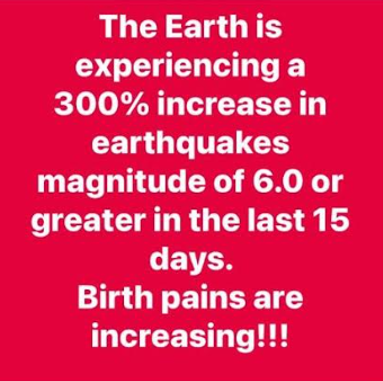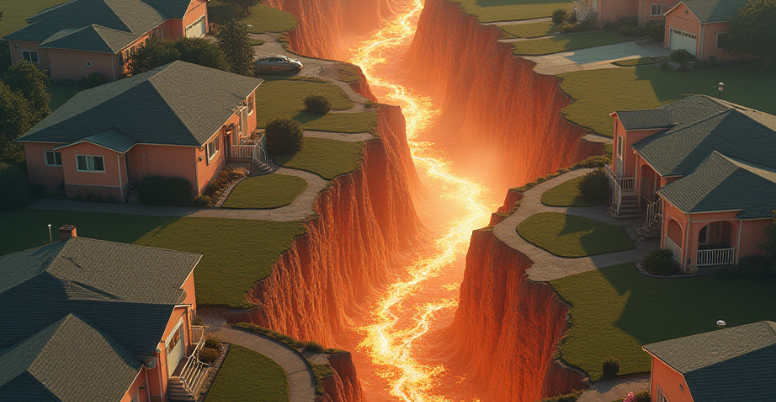Hal Lindsey continued to make predictions even after his failed 1948 (Israel’s nationhood) + 40 (the number of years that determine a generation) = 1988 (when the rapture would take place) failed miserably. A few years before his death in 2024, he said this about earthquakes and the last days:
As we grow closer to the end of this Age of Grace, it may become harder and harder to find places that are beyond the reach of earthquakes. In Matthew 24:7, Jesus warned that in these final days there will be an increase in the frequency and intensity of earthquakes in the world. In Luke 21:22, He spoke of “great earthquakes. …”
Lindsey played the earthquake card many times. He started in 1970 with the publication of his book The Late Great Planet Earth.[1] In 1997, he wrote, “Earthquakes continue to increase in frequency and intensity, just as the Bible predicts for the last days before the return of Christ.”[2]
In 1994, he published similar statistics in the first edition of Planet Earth 2000 A.D. from the United States Geological Survey in Boulder, Colorado. “But he does not give details of the report (report name, author, date, location, etc.).”[3]

Last Days Madness
In this authoritative book, Gary DeMar clears the haze of "end-times" fever, shedding light on the most difficult and studied prophetic passages in the Bible, including Daniel 7:13-14; 9:24-27; Matt. 16:27-28; 24-25; Thess. 2; 2 Peter 3:3-13, and clearly explaining a host of other controversial topics.
Buy NowIs Lindsey right? He quotes Matthew 24:7: “For nation will rise against nation, and kingdom against kingdom, and in various places there will be famines and earthquakes.” Do either Matthew 24:7 or Luke 21:11 (not 21:22) say “there will be an increase in the frequency and intensity of earthquakes in the world”? No. It only says there will be famines and earthquakes. As the Bible and history attest, there were famines and earthquakes from AD 30 to 70.
Following in the failed prophetic footsteps of Lindsey, I saw this meme on Facebook.

It seems that there are more earthquakes today because of several factors:
In 1931, there were about 350 [seismic] stations operating in the world; today [2011], there are more than 4,000 stations and the data now comes in rapidly from these stations by telex, computer and satellite. This increase in the number of stations and the more timely receipt of data has allowed us and other seismological centers to locate many small earthquakes which were undetected in earlier years, and we are able to locate earthquakes more rapidly. The NEIC now locates about 12,000 to 14,000 earthquakes each year or approximately 35 per day. Also, because of the improvements in communications and the increased interest in natural disasters, the public now learns about more earthquakes. According to long-term records (since about 1900), we expect about 18 major earthquakes (7.0-7.9) and one great earthquake (8.0 or above) in any given year. (Fact Check)
As history attests, devastating earthquakes are not new. Consider the Lisbon earthquake of 1755. “The estimates of the death toll range from about 15,000 to more than 75,000. Modern historians incline to believe that the correct figure is probably about 30,000, which would be more than ten percent of the city’s population, the equivalent of nearly a million in contemporary New York.”[4]
Recent devastating earthquakes in Haiti, Chile and China, as well as magnitude 7 plus earthquakes in Indonesia and California, might give the impression that earthquake activity is increasing. In fact, a quick look at earthquake statistics over the last twenty years shows that this is not the case. … Earthquakes in populated places are far more noticed than the many that occur in remote regions, so when, by chance, a run of earthquakes hit population centres, it appears that the number of events has increased. … Global communication. Vast improvements in global communications mean we have near instant pictures of devastating earthquakes from all around the world. This means more people are aware of earthquakes and their impact.[5]
The biblical record shows that earthquakes occurred before Jerusalem was destroyed in AD 70. Two earthquakes are recorded in Matthew’s Gospel: When Jesus was crucified (27:54) and when the angel came down to roll the stone away from the tomb where Jesus was buried (28:2). This second earthquake is said to have been mega, the Greek word for “great.”
Luke records “a great earthquake” shook “the foundations of the prison house” (Acts 16:26). In Revelation 11:13 we find, “And in that hour there was a great earthquake, and a tenth of the city fell; and seven thousand people were killed in the earthquake, and the rest were terrified and gave glory to the God of heaven.” The temple was still standing when John recorded this event (11:1-2).
Secular historians of the time support the biblical record. “And as to earthquakes, many are mentioned by writers during a period just previous to 70 A.D. There were earthquakes in Crete, Smyrna, Miletus, Chios, Samos, Laodicea, Hierapolis, Colosse, Campania, Rome, and Judea. It is interesting to note that the city of Pompeii was much damaged by an earthquake occurring on February 5, 63 A.D.”[6] Henry Alford compiled the following list:
The principal earthquakes occurring between this prophecy and the destruction of Jerusalem [in AD 70] were, (1) a great earthquake in Crete, A.D. 46 or 47; (2) one at Rome on the day when Nero assumed the manly toga, A.D. 51; (3) one at Apamaea in Phrygia, mentioned by Tacitus, A.D. 53; (4) one at Laodicea in Phrygia, A.D. 60; (5) one in Campania. Seneca, in the year, A.D. 58, writes:—“How often have cities of Asia and Achaea fallen with one fatal shock! How many cities have been swallowed up in Syria, how many in Macedonia! How often has Cyprus been wasted by this calamity! How often has Paphos become a ruin! News has often been brought us of the demolition of whole cities at once.”[7]
Notice the tight geographical area of these earthquakes within 12 years. They occurred in the known world, the oikoumenē (Matt. 24:14; Luke 2:1; Acts 11:28; 17:6, 31).
Flavius Josephus, an eyewitness to the events surrounding Jerusalem’s destruction, describes an earthquake in Judea of such magnitude “that the constitution of the universe was confounded for the destruction of men.”[8] Josephus goes on to write that the Judean earthquake was “no common” calamity, indicating that God Himself had brought it about for a special purpose. One commentator wrote: “Perhaps no period in the world’s history has ever been so marked by these convulsions as that which intervenes between the Crucifixion and the destruction of Jerusalem.”[9] Since the generation between AD 30 and 70 is past, there is no reason to attach prophetic significance to earthquakes in our day as a fulfillment of Matthew 24:7. They are not signs of Jesus’ return in our generation, but they were a prelude to the coming of Jesus in judgment upon Jerusalem in the generation of the apostles.

Prophecy Wars: The Biblical Battle Over the End Times
There is a long history of skeptics turning to Bible prophecy to claim that Jesus was wrong about the timing of His coming at “the end of the age” (Matt. 24:3) and the signs associated with it. Noted atheist Bertrand Russell (1872-1970) is one of them and Bart Ehrman is a modern example. It’s obvious that neither Russell or Ehrman are aware of or are ignoring the mountain of scholarship that was available to them that showed that the prophecy given by Jesus was fulfilled in great detail just as He said it would be before the generation of His day passed away.
Buy NowToday’s reported earthquakes are not unique, as proven by a thorough study of history. The greatest student of earthquakes was a Frenchman, Count F. Montessus de Ballore (1851-1923). From 1885 to 1922 he devoted his life to studying and cataloging earthquakes and came to an astonishing conclusion. He cataloged 171,434 earthquakes from the earliest historic times! “The manuscript is stored in the library of the Geographical Society in Paris, where it occupies 26 meters (over 84 feet) of bookshelves.”[10] As much as we might want to believe that we are the “Rapture Generation,” as Lindsey and other prophecy writers claim, there is no statistical or biblical evidence to support their claim.
[1] The Late Great Planet Earth (Grand Rapids, MI: Zondervan, 1970), 52.
[2] Hal Lindsey, Apocalypse Code (Palos Verdes, CA: Western Front Ltd., 1997), 296.
[3] Steven A. Austin and Mark L. Strauss, “Are Earthquakes Signs of the End Times?: A Geological and Biblical Response to an Urban Legend,” Christian Research Journal, 21:4, 32. Through careful analysis, the authors refute the claim that there has been an increase of earthquakes in the periods stated by the above prophecy writers. In fact, the authors conclude, “Graphical plots of global earthquake frequency indicate overall a decreasing frequency of earthquakes” (38). A more technical version of their study is published here.
[4] Otto Friedrich, The End of the World: A History (New York: Coward, McCann and Geoghegan, 1982), 188.
[5] https://www.earthquakes.bgs.ac.uk/news/EQ_increase.html
[6] J. Marcellus Kik, Matthew Twenty-Four: An Exposition (Philadelphia, PA: Presbyterian and Reformed, 1948), 93.
[7] Henry Alford, The New Testament for English Readers (Chicago, IL: Moody Press, n.d.), 163.
[8] Quoted in Thomas Scott, The Holy Bible Containing the Old and New Testaments, According to the Authorized Version; with Explanatory Notes, Practical Observations, and Copious Marginal References, 3 vols. (New York: Collins and Hannay, 1832), 3:108.
[9] Edward Hayes Plumptre, “The Gospel According to St. Matthew,” Ellicott’s Commentary on the Whole Bible, ed. Charles John Ellicott, 8 vols. (London: Cassell and Company, 1897), 6:146.
[10] Carl Olof Jonsson and Wolfgang Herbst, The “Sign” of the Last Days—When? (Atlanta: Commentary Press, 1987), 78.

